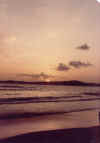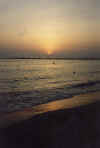| Sunsets are among the most photographed subjects on
earth. Its amazingly simple to do them. Sunrises are a tad more difficult. The best thing about sunset photography is, you can then continue shooting
into the night. Dusk and night time photography are among the most satisfying of subjects
to capture on film. Everyday, run of the mill objects around town begin to take on a
magical color and tint in the fading daylight. The lights that come on have a totally
magical effect on the mind, and make even mundane subjects look very different indeed.
Here is a short webpage about sunset, sunrise and dusk photography.
This short webpage serves to illustrate what I'd posted yesterday (21 Nov.2002) on the SLR
Photo group. The captions are self explanatory. |












